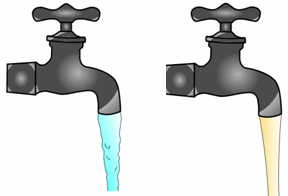 A turbulent flow (or) a steady flow depends on the viscosity of the fluid:
Fluid with more viscosity has a steady flow.
A turbulent flow (or) a steady flow depends on the viscosity of the fluid:
Fluid with more viscosity has a steady flow.
There are two types of flow, namely streamline flow and turbulent flow:
(1) Streamline flow (or) steady flow : The flow of a liquid is said to be streamline flow or steady flow if all the liquid particles that pass any given point follow the same path at the same speed (i.e., they have the same velocity).
Streamlines cannot cross. If they were to do so, particles reaching the intersection would not have a unique velocity at that point in space. A bundle of streamlines such as those shown is called a tube of flow. Since the streamlines represent the paths of particles, we see that no liquid can flow into or out of the sides of a tube of flow. In a steady flow, the velocity, density and pressure at each point in the liquid do not change with time.
Laminar flow is a special case of streamline or steady flow in which the liquid flows as a series of parallel layers and no layer crosses another layer. Thus smooth streamline flow is known as laminar flow.
(2) Turbulent (or) Complicated flow : The flow of a liquid is said to be turbulent flow, if the speed and direction of the liquid particles passing any point change with time. Figure shows the turbulent flow of a liquid moving through a narrow constriction. Instead of following a given path, the particles of the liquid form whirlpool patterns called eddies. Generally, turbulent flow occurs in liquids moving at high speeds. When the velocity of the liquid is small, the flow is laminar or steady. However, if the velocity of liquid exceeds certain limiting value called critical velocity, the steady flow changes into turbulent flow.